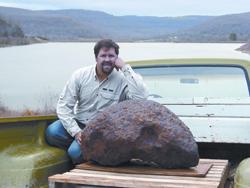
"I've purchased meteorites from at least two dozen farmers over the past 10 or 15 years," says Steve Arnold, the meteorite hunter who found a record-breaking 1,430-lb. meteorite 7 ft. below ground on a Kansas farmer's land (see story inside this issue).
"I know there are meteorites laying under fence rows, holding down roofs on chicken sheds, and holding barn doors open and people don't even realize they're worth a lot of money," he says.
Here are some tips he gives to help determine whether or not a rock is a meteorite.
-- 95 percent of meteorites that are found are of the stone type and 5 percent are iron or stoney-iron.
-- Stone meteorites contain about 20 percent iron. Stoney-iron and Iron meteorites range from 50 to 95 percent iron type.
-- Stone meteorites are about twice as heavy as a normal rock.
-- Stoney-iron and iron meteorites are about three times as heavy as a normal rock.
-- A strong magnet will be attracted to most meteorites.
-- Exteriors will be rusty unless freshly fallen in which case they will have black to dark gray surfaces.
-- Corners will be rounded off.
-- The surface can be smooth but can't have air bubbles like cinders.
If a rock fits this description, especially the magnet test, examination by a professional is strongly encouraged.
"I'm happy to examine potential meteorites free of charge," says Arnold.
